 The three surviving species of manatees belong to the family Trichechidae. They are made up of the West Indian manatee (Trichechus manatus), ranging the waters of the continental United States northward along Florida's Gulf and Atlantic coasts and south to below the Amazon river. The Amazonian manatee (Trichechus inunguis) confines itself to the Amazon river and its tributaries. The African manatee (Trichechus senegalensis) ranges the coastal waters and larger rivers from Senegal to Angola.
The three surviving species of manatees belong to the family Trichechidae. They are made up of the West Indian manatee (Trichechus manatus), ranging the waters of the continental United States northward along Florida's Gulf and Atlantic coasts and south to below the Amazon river. The Amazonian manatee (Trichechus inunguis) confines itself to the Amazon river and its tributaries. The African manatee (Trichechus senegalensis) ranges the coastal waters and larger rivers from Senegal to Angola.
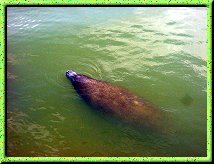 All three species - the West Indian, Amazonian, and African manatees are declining in population because they have been heavily hunted, though it is illegal to hunt them in the United States. In the United States the problem is of habitat sharing with humans and the results of that. Specifically, injuries or deaths that result from fast boats. Manatees swim at about 3 to 5 miles per hour, and any boat that travels faster than 15 to 20 miles per hour is capable of injuring or killing a manatee. The pictures that you see on this page show manatees with scars from those type of injuries. These photographs have been enhanced to take the glare from the water off of them, making the manatees more visible. But unless you are boating slowly and carefully and wearing polorized glasses, it is very hard to see them since usually only the tips of their noses with the nostrals are visible.
All three species - the West Indian, Amazonian, and African manatees are declining in population because they have been heavily hunted, though it is illegal to hunt them in the United States. In the United States the problem is of habitat sharing with humans and the results of that. Specifically, injuries or deaths that result from fast boats. Manatees swim at about 3 to 5 miles per hour, and any boat that travels faster than 15 to 20 miles per hour is capable of injuring or killing a manatee. The pictures that you see on this page show manatees with scars from those type of injuries. These photographs have been enhanced to take the glare from the water off of them, making the manatees more visible. But unless you are boating slowly and carefully and wearing polorized glasses, it is very hard to see them since usually only the tips of their noses with the nostrals are visible.
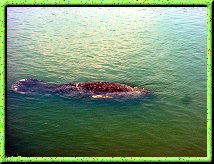 Manatees are dying in record numbers due to human activities, by far the single most siginificant cause for mortalities is recreational boating in Florida's congested waters. At least 100 have been killed by boating accidents each year for the past ten years. In 1990 alone 218 were killed of the total United States poplation of about 1,850 manatees. Another hazard to manatees is a red tide. A red tide referrs to a hugh "blooming" of tiny marine organisms called dinoflagellates. It causes the water to appear to be red, green or yellow. It gives off a toxic byproduct that affects the central nervous system of creatures in the area of a "bloom". This occurred in Florida in 1996 and killed 15% of the known west coast population of manatees. A red tide is a naturally occurring event that cannot be prevented. Scientists have discovered that red tides need high salinity water to survive, and are trying to find ways to keep that from happening.
Manatees are dying in record numbers due to human activities, by far the single most siginificant cause for mortalities is recreational boating in Florida's congested waters. At least 100 have been killed by boating accidents each year for the past ten years. In 1990 alone 218 were killed of the total United States poplation of about 1,850 manatees. Another hazard to manatees is a red tide. A red tide referrs to a hugh "blooming" of tiny marine organisms called dinoflagellates. It causes the water to appear to be red, green or yellow. It gives off a toxic byproduct that affects the central nervous system of creatures in the area of a "bloom". This occurred in Florida in 1996 and killed 15% of the known west coast population of manatees. A red tide is a naturally occurring event that cannot be prevented. Scientists have discovered that red tides need high salinity water to survive, and are trying to find ways to keep that from happening.
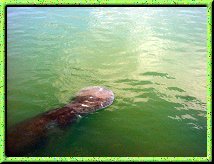 Adults may grow to lengths of 15 feet, and weigh from several hundred to more than two thousand pounds. They are stout, thick-skinned, and almost hairless with a broad, shovel-like tail. They have only one pair of limbs, front flippers which they use to push algae, such as seaweed and other water plants toward their mouths. They eat a variety of marine and freshwater vegetation including Hydrilla. Hydrilla is a non-native and invasive vegatation that will overrun native species. So the manatee is helpful in the fact that they will eat it.
Adults may grow to lengths of 15 feet, and weigh from several hundred to more than two thousand pounds. They are stout, thick-skinned, and almost hairless with a broad, shovel-like tail. They have only one pair of limbs, front flippers which they use to push algae, such as seaweed and other water plants toward their mouths. They eat a variety of marine and freshwater vegetation including Hydrilla. Hydrilla is a non-native and invasive vegatation that will overrun native species. So the manatee is helpful in the fact that they will eat it.
Manatees probably share a common ancestor with elephants. Their molars, like those of elephants, are continuously replaced with new teeth that move forward from the back of the jaw as the old ones wear down and are pushed out.
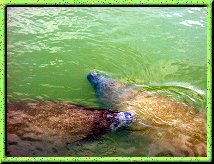 Manatees are unique among mammals in that they spend their entire lives in the water. They surface to breathe every three to four minutes and spend their time eating, resting, and traveling. And they are gentle. They will not fight - even to save its own life. When faced with danger, its only defense is a hasty retreat at speeds of up to 5 miles an hour. Manatees frequently communicate by muzzle -to -muzzle contact and, when alarmed, emit chirpy squeaks.
Manatees are unique among mammals in that they spend their entire lives in the water. They surface to breathe every three to four minutes and spend their time eating, resting, and traveling. And they are gentle. They will not fight - even to save its own life. When faced with danger, its only defense is a hasty retreat at speeds of up to 5 miles an hour. Manatees frequently communicate by muzzle -to -muzzle contact and, when alarmed, emit chirpy squeaks.
Satellite-monitored radio transmitters are now being used to follow the movements of manatees. It also enables scientists to identify and study manatees calving and feeding. It has been learned that females reach maturity between 5 and 9 years of age. It is believed that one calf is born every 2 1/2 to 3 years. Manatees are susceptible to cold-related diseases, so they will keep to warmer waters in the winter, usually November through March. In the United States, this means most head to Florida to congregate near natural springs or warm water created by power plants. Manatees often return to the same wintering places every year. In the summer months manatees can be found as far west as Texas and as far north as Virginia, though this is not common.
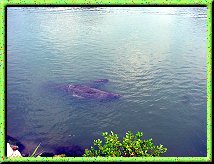 All the pictures on this page were taken by me of the West Indian manatee (Trichechus manatus) and were taken in Florida at the Merritt Island National Wildlife Refuge in May 2005. These were taken at the manatee viewing platform on the Haulover canal off of Mosquito Lagoon. West Indian manatees can grow up to 12 feet in length and weigh up to 2,000 pounds. They live in fresh, brackish, and marine waters. They have no natural enemies and can live over 60 years. Their diet consists of seagrasses and other aquatic plants and they eat 150 to 200 pounds a day. Their gestation lasts about 13 months with one calf born every two to three years. The manatees are often found in the Merritt Island National Wildlife Refuge, where in the spring of 1994 over 300 manatees were counted. That was over 50% of the east coast population at the time.
All the pictures on this page were taken by me of the West Indian manatee (Trichechus manatus) and were taken in Florida at the Merritt Island National Wildlife Refuge in May 2005. These were taken at the manatee viewing platform on the Haulover canal off of Mosquito Lagoon. West Indian manatees can grow up to 12 feet in length and weigh up to 2,000 pounds. They live in fresh, brackish, and marine waters. They have no natural enemies and can live over 60 years. Their diet consists of seagrasses and other aquatic plants and they eat 150 to 200 pounds a day. Their gestation lasts about 13 months with one calf born every two to three years. The manatees are often found in the Merritt Island National Wildlife Refuge, where in the spring of 1994 over 300 manatees were counted. That was over 50% of the east coast population at the time.
Merritt Island established a 10,500 acre "No Motor Zone" in March of 1990 in the northern Banana River to protect the manatees. This area with part of the Banana River that falls in the NASA security area forms the largest contiguous manatee protection area in Florida. No motorized vehicles are allowed. But, you can go in the Merritt Island part in a canoe, sailboat, or any other wind or human powered craft.
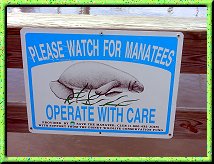
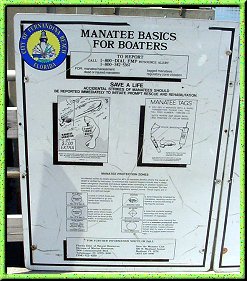 Manatees are protected by both state and federal laws. The federal laws are the Marine Mammel Protection Act of 1972 and the Endangered Species Act of 1973. Florida protects the manatees with the Florida Manatee Sanctuary Act of 1978. Though the US Fish and Wildlife Service has announced that it will perform a 5 year review of the listing status of the Florida (West Indian) Manatee. They could have done this every five years since they were listed as endangered but this is the first time it has been done. This is not good. It is probably pushed by boating groups and developers. For more information on what you can do to help is to go to Save The Manatee Club and keep checking with them. They have been around since 1981, when established by former Florida Governor Bob Graham and Jimmy Buffett so the public could participate in conservation efforts to save manatees from extinction. They even provide signs like the one pictured here for boating areas, to keep the public aware of manatees and safe boating in manatee areas.
Manatees are protected by both state and federal laws. The federal laws are the Marine Mammel Protection Act of 1972 and the Endangered Species Act of 1973. Florida protects the manatees with the Florida Manatee Sanctuary Act of 1978. Though the US Fish and Wildlife Service has announced that it will perform a 5 year review of the listing status of the Florida (West Indian) Manatee. They could have done this every five years since they were listed as endangered but this is the first time it has been done. This is not good. It is probably pushed by boating groups and developers. For more information on what you can do to help is to go to Save The Manatee Club and keep checking with them. They have been around since 1981, when established by former Florida Governor Bob Graham and Jimmy Buffett so the public could participate in conservation efforts to save manatees from extinction. They even provide signs like the one pictured here for boating areas, to keep the public aware of manatees and safe boating in manatee areas.

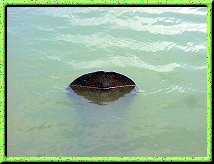


 The three surviving species of manatees belong to the family Trichechidae. They are made up of the West Indian manatee (Trichechus manatus), ranging the waters of the continental United States northward along Florida's Gulf and Atlantic coasts and south to below the Amazon river. The Amazonian manatee (Trichechus inunguis) confines itself to the Amazon river and its tributaries. The African manatee (Trichechus senegalensis) ranges the coastal waters and larger rivers from Senegal to Angola.
The three surviving species of manatees belong to the family Trichechidae. They are made up of the West Indian manatee (Trichechus manatus), ranging the waters of the continental United States northward along Florida's Gulf and Atlantic coasts and south to below the Amazon river. The Amazonian manatee (Trichechus inunguis) confines itself to the Amazon river and its tributaries. The African manatee (Trichechus senegalensis) ranges the coastal waters and larger rivers from Senegal to Angola. All three species - the West Indian, Amazonian, and African manatees are declining in population because they have been heavily hunted, though it is illegal to hunt them in the United States. In the United States the problem is of habitat sharing with humans and the results of that. Specifically, injuries or deaths that result from fast boats. Manatees swim at about 3 to 5 miles per hour, and any boat that travels faster than 15 to 20 miles per hour is capable of injuring or killing a manatee. The pictures that you see on this page show manatees with scars from those type of injuries. These photographs have been enhanced to take the glare from the water off of them, making the manatees more visible. But unless you are boating slowly and carefully and wearing polorized glasses, it is very hard to see them since usually only the tips of their noses with the nostrals are visible.
All three species - the West Indian, Amazonian, and African manatees are declining in population because they have been heavily hunted, though it is illegal to hunt them in the United States. In the United States the problem is of habitat sharing with humans and the results of that. Specifically, injuries or deaths that result from fast boats. Manatees swim at about 3 to 5 miles per hour, and any boat that travels faster than 15 to 20 miles per hour is capable of injuring or killing a manatee. The pictures that you see on this page show manatees with scars from those type of injuries. These photographs have been enhanced to take the glare from the water off of them, making the manatees more visible. But unless you are boating slowly and carefully and wearing polorized glasses, it is very hard to see them since usually only the tips of their noses with the nostrals are visible.
 Manatees are dying in record numbers due to human activities, by far the single most siginificant cause for mortalities is recreational boating in Florida's congested waters. At least 100 have been killed by boating accidents each year for the past ten years. In 1990 alone 218 were killed of the total United States poplation of about 1,850 manatees. Another hazard to manatees is a red tide. A red tide referrs to a hugh "blooming" of tiny marine organisms called dinoflagellates. It causes the water to appear to be red, green or yellow. It gives off a toxic byproduct that affects the central nervous system of creatures in the area of a "bloom". This occurred in Florida in 1996 and killed 15% of the known west coast population of manatees. A red tide is a naturally occurring event that cannot be prevented. Scientists have discovered that red tides need high salinity water to survive, and are trying to find ways to keep that from happening.
Manatees are dying in record numbers due to human activities, by far the single most siginificant cause for mortalities is recreational boating in Florida's congested waters. At least 100 have been killed by boating accidents each year for the past ten years. In 1990 alone 218 were killed of the total United States poplation of about 1,850 manatees. Another hazard to manatees is a red tide. A red tide referrs to a hugh "blooming" of tiny marine organisms called dinoflagellates. It causes the water to appear to be red, green or yellow. It gives off a toxic byproduct that affects the central nervous system of creatures in the area of a "bloom". This occurred in Florida in 1996 and killed 15% of the known west coast population of manatees. A red tide is a naturally occurring event that cannot be prevented. Scientists have discovered that red tides need high salinity water to survive, and are trying to find ways to keep that from happening. Adults may grow to lengths of 15 feet, and weigh from several hundred to more than two thousand pounds. They are stout, thick-skinned, and almost hairless with a broad, shovel-like tail. They have only one pair of limbs, front flippers which they use to push algae, such as seaweed and other water plants toward their mouths. They eat a variety of marine and freshwater vegetation including Hydrilla. Hydrilla is a non-native and invasive vegatation that will overrun native species. So the manatee is helpful in the fact that they will eat it.
Adults may grow to lengths of 15 feet, and weigh from several hundred to more than two thousand pounds. They are stout, thick-skinned, and almost hairless with a broad, shovel-like tail. They have only one pair of limbs, front flippers which they use to push algae, such as seaweed and other water plants toward their mouths. They eat a variety of marine and freshwater vegetation including Hydrilla. Hydrilla is a non-native and invasive vegatation that will overrun native species. So the manatee is helpful in the fact that they will eat it. Manatees are unique among mammals in that they spend their entire lives in the water. They surface to breathe every three to four minutes and spend their time eating, resting, and traveling. And they are gentle. They will not fight - even to save its own life. When faced with danger, its only defense is a hasty retreat at speeds of up to 5 miles an hour. Manatees frequently communicate by muzzle -to -muzzle contact and, when alarmed, emit chirpy squeaks.
Manatees are unique among mammals in that they spend their entire lives in the water. They surface to breathe every three to four minutes and spend their time eating, resting, and traveling. And they are gentle. They will not fight - even to save its own life. When faced with danger, its only defense is a hasty retreat at speeds of up to 5 miles an hour. Manatees frequently communicate by muzzle -to -muzzle contact and, when alarmed, emit chirpy squeaks. All the pictures on this page were taken by me of the West Indian manatee (Trichechus manatus) and were taken in Florida at the
All the pictures on this page were taken by me of the West Indian manatee (Trichechus manatus) and were taken in Florida at the 
 Manatees are protected by both state and federal laws. The federal laws are the Marine Mammel Protection Act of 1972 and the Endangered Species Act of 1973. Florida protects the manatees with the Florida Manatee Sanctuary Act of 1978. Though the US Fish and Wildlife Service has announced that it will perform a 5 year review of the listing status of the Florida (West Indian) Manatee. They could have done this every five years since they were listed as endangered but this is the first time it has been done. This is not good. It is probably pushed by boating groups and developers. For more information on what you can do to help is to go to
Manatees are protected by both state and federal laws. The federal laws are the Marine Mammel Protection Act of 1972 and the Endangered Species Act of 1973. Florida protects the manatees with the Florida Manatee Sanctuary Act of 1978. Though the US Fish and Wildlife Service has announced that it will perform a 5 year review of the listing status of the Florida (West Indian) Manatee. They could have done this every five years since they were listed as endangered but this is the first time it has been done. This is not good. It is probably pushed by boating groups and developers. For more information on what you can do to help is to go to